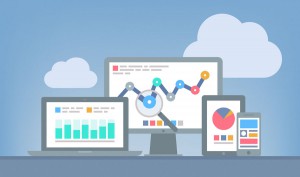Today’s entry develops further on the guide related to Google Analytics published in February. If you already have Analytics installed, you measure traffic at the proprietary website and collect data, you will learn what conclusions follow from the collected data and how to use it to improve school’s competitiveness.
In the first entry about Google Analytics we wrote why it is worthwhile to use this tool, how to install the application correctly at your website and we listed basic pieces of info we can obtain owing to this application. If the first steps are already behind you, it is worthwhile learning about other opportunities offered by Google Analytics.
- Traffic intensification – it shows the days and hours when the traffic at the website and interest in the product is the greatest. What can be concluded this way? If traffic intensifies on weekdays from 8 a.m. then this means that info at the proprietary website is searched not by school-age children, who start classes at that time, but rather by office workers, for example. So perhaps it is worthwhile expanding the offer of business language courses for adults?
- Starting point – the most popular page from the viewpoint of search engines or one containing the most interesting content to which users are redirected by inputting the address (the latter option is less likely). Most usually this is a subpage containing a very interesting piece of info, which is powerfully promoted by Google in search results. Such subpage may attract user traffic to our website. It is worthwhile drawing greater attention to such subpage and expand it further, e.g. with graphics or video content, and make sure that all links on that page are legible, clearly visible and lead to other major subpages. This will help redirect Internet users to other spots of our website. This data is worthwhile to be analysed; this will help you to create even more high-quality content, which will attract traffic and interest to the website.
- Exit point – the page visited by users as the last one. Why is that important? If, for example, the last viewed page is the subpage with prices, and after reading it users leave the website without going to the “contact” tab to write an e-mail or make a phone call and learn more about the offer, this can mean that prices are unrealistic.
- Phrases – the most popular keywords, owing to which potential customers will visit/find the website. This is a very important function, because it will help you to learn a lot about your customers. For example, it they enter the website of your language school by inputting “English for children”, this may mean that a given keyword is very well-positioned. Perhaps some other websites provide links to your website using exactly this keyword?
If you are currently developing a new offer, for example of business German courses, you should order a campaign for phrase “business German” from a company concerned with positioning.
It happens sometimes that Internet users come to your website by inputting a keyword not related to your current activities, for example “French for beginners”. Think why this so. Perhaps your website still contains an offer of courses which you in reality no longer offer? Try to correct this because Internet users do not like viewing pages that mislead them.
But this is not the end of the info you can obtain owing to an analysis of phrases from Google Analytics. It can turn out that Internet users, for example, input the full name of a specific course instructor. This can be an important signal for you – such person is a very good teacher if people input his/her name in the search engine. Check what makes such a teacher stand out. Perhaps his/her methods can be implemented in your school on a wider scale, and consequently improve customer satisfaction? Remember about this when making staffing decisions.
- Referring sites – external websites referring to our service/store. This function is strongly related to phrases and overall positioning of a page in the search engine. A general rule is as follows: the greater is the number of credible, frequently updated sites that provide links to your website, the more credible your website is. It can turn out that you pay to some portal for an ad campaign but it generates little traffic. It is easier to make decision on potential suspension of certain actions if we have specific data. You can also learn about efficient sources of traffic and think about cooperation with them.
Are those all functions of Google Analytics? Of course not. We will return to the topics of both Google Analytics and online marketing many times more in the future. What is the most popular phrase that takes Internet users to your website? Write about it in the comments 🙂

